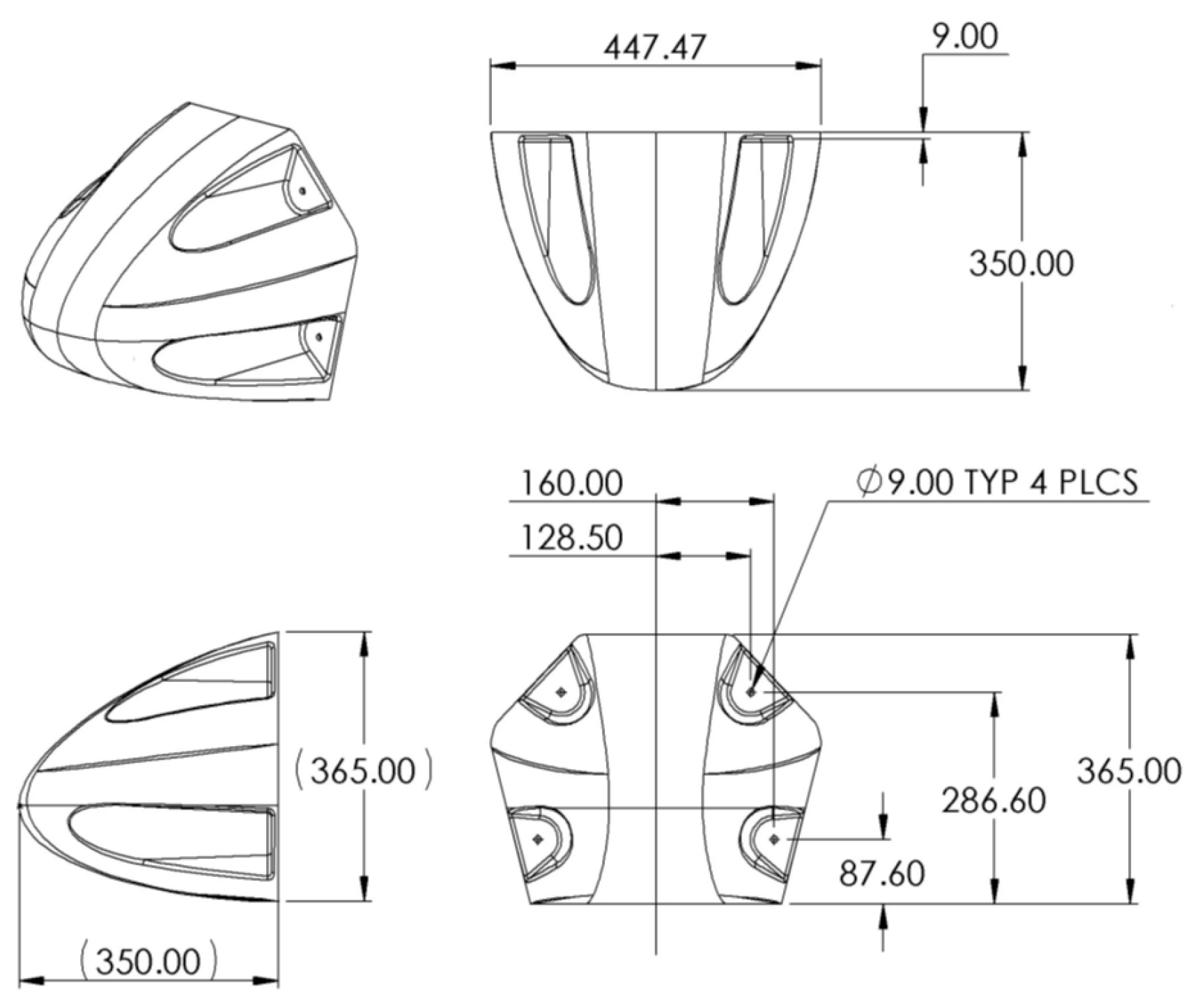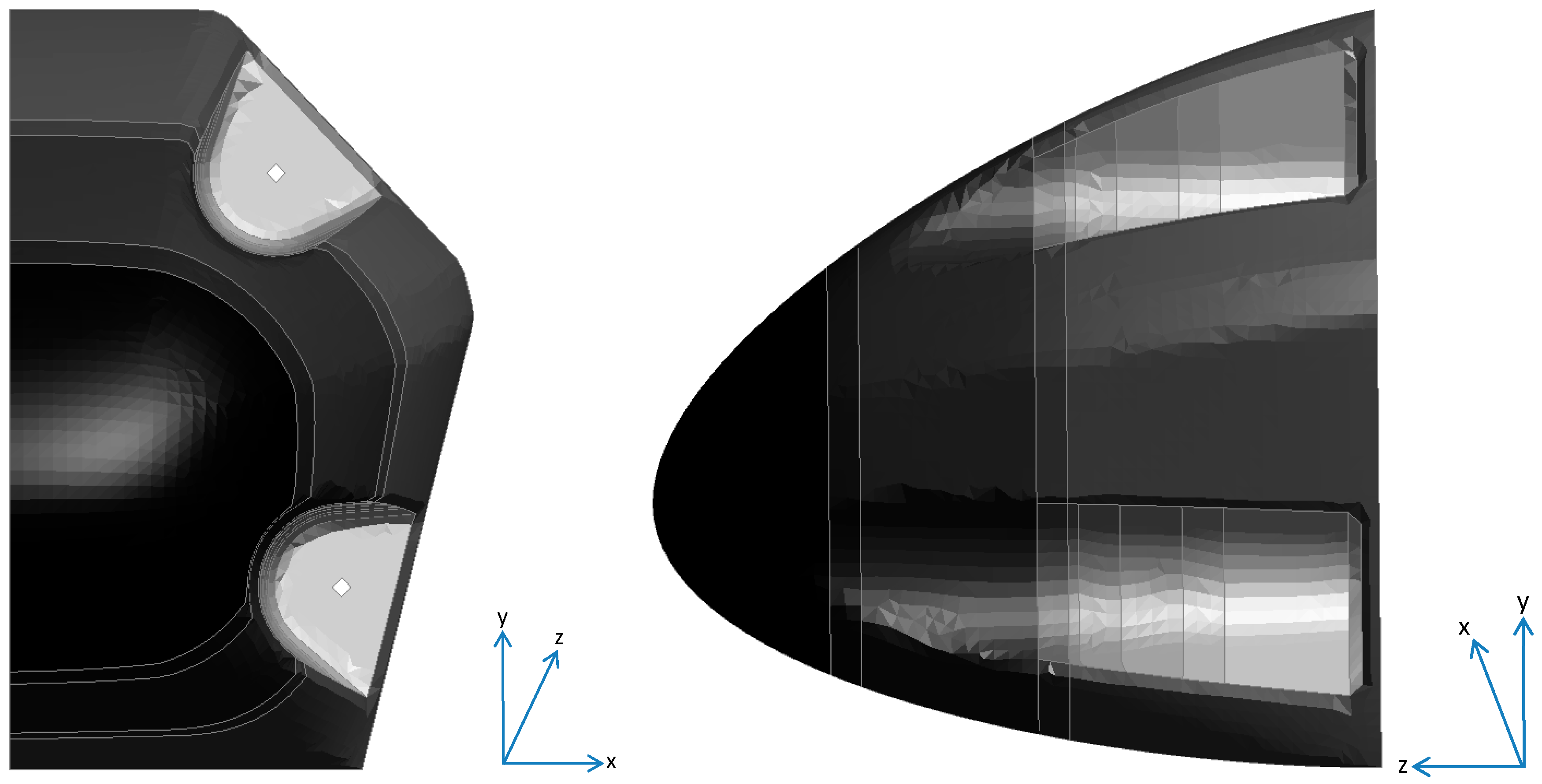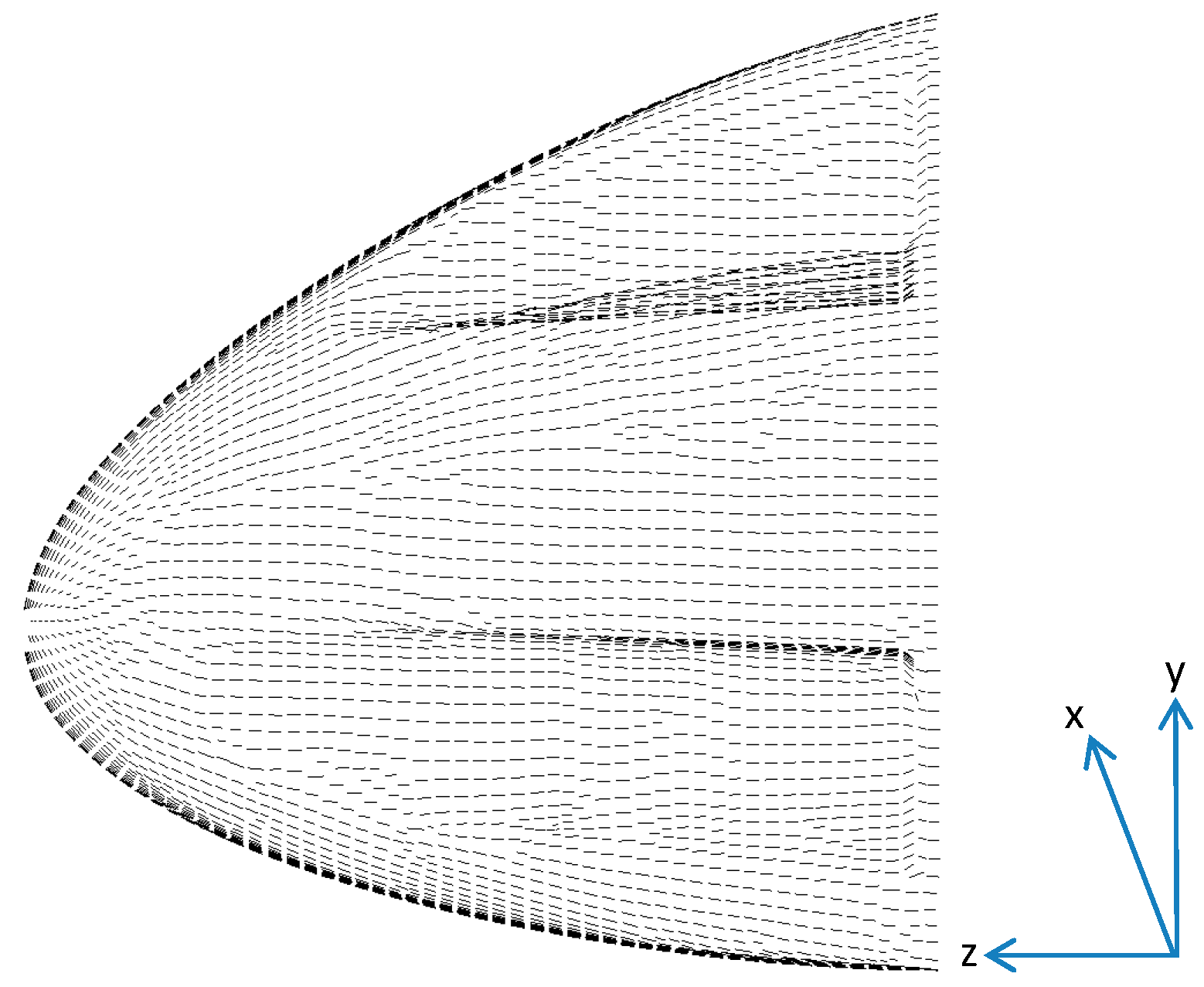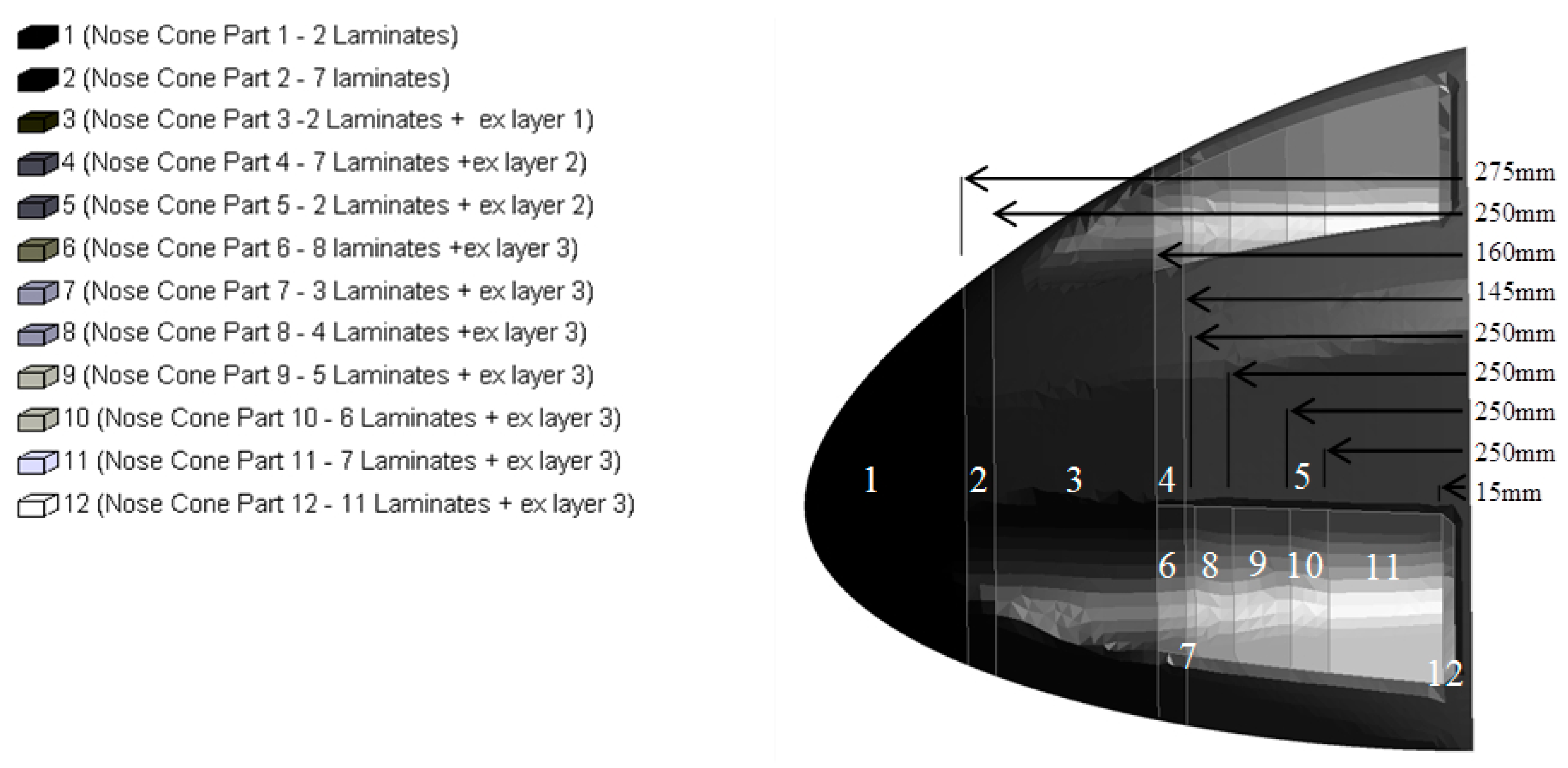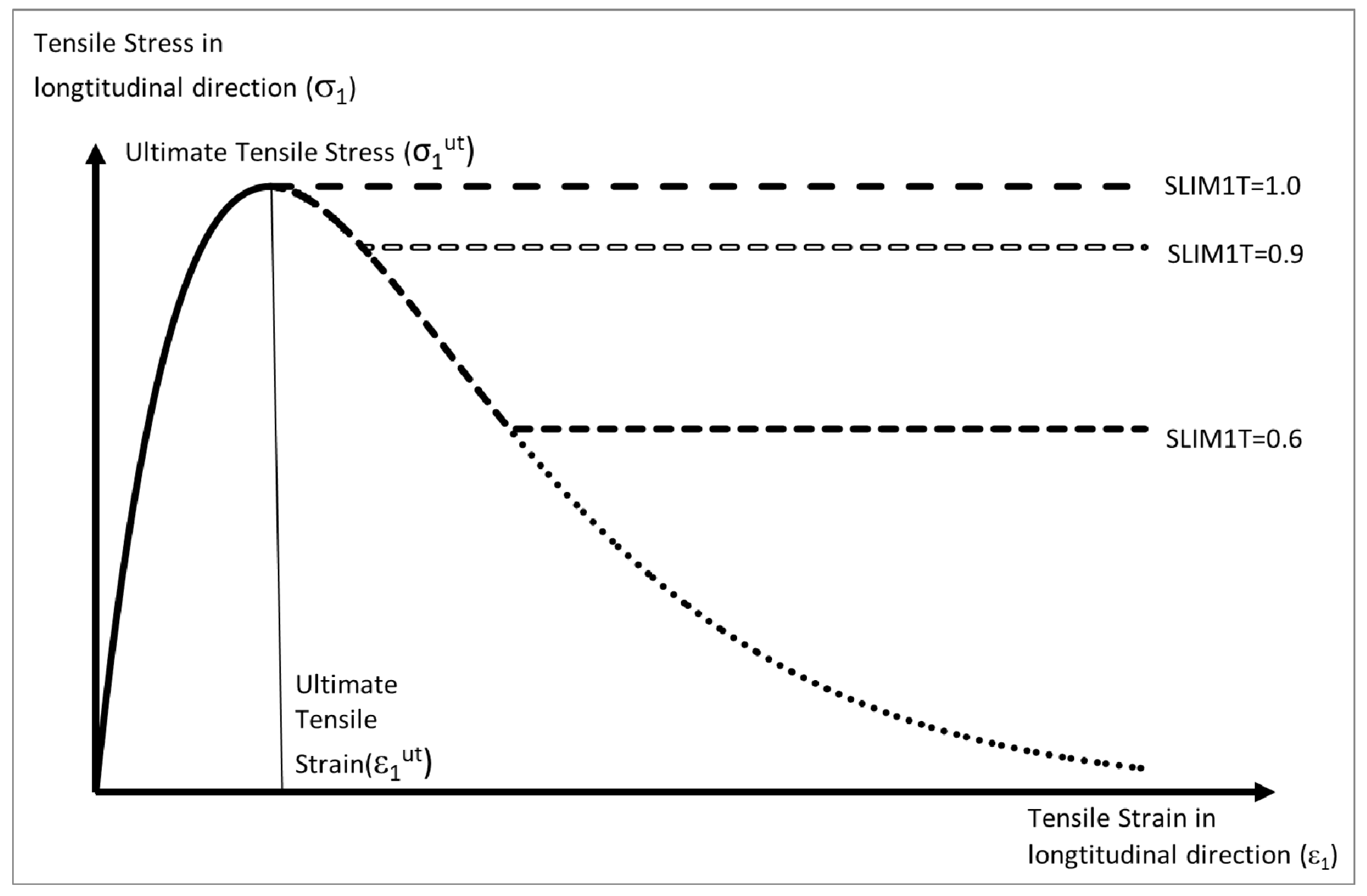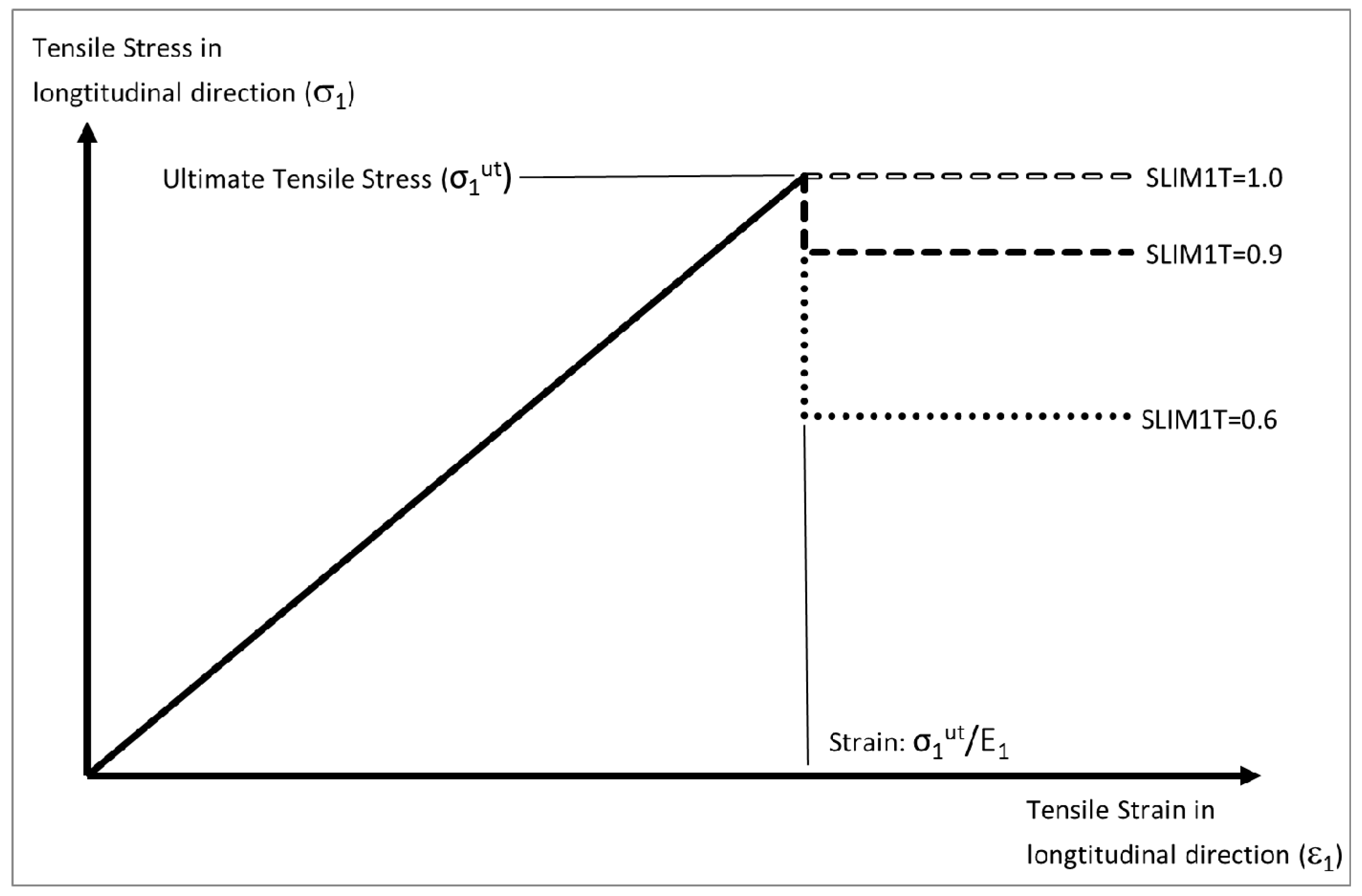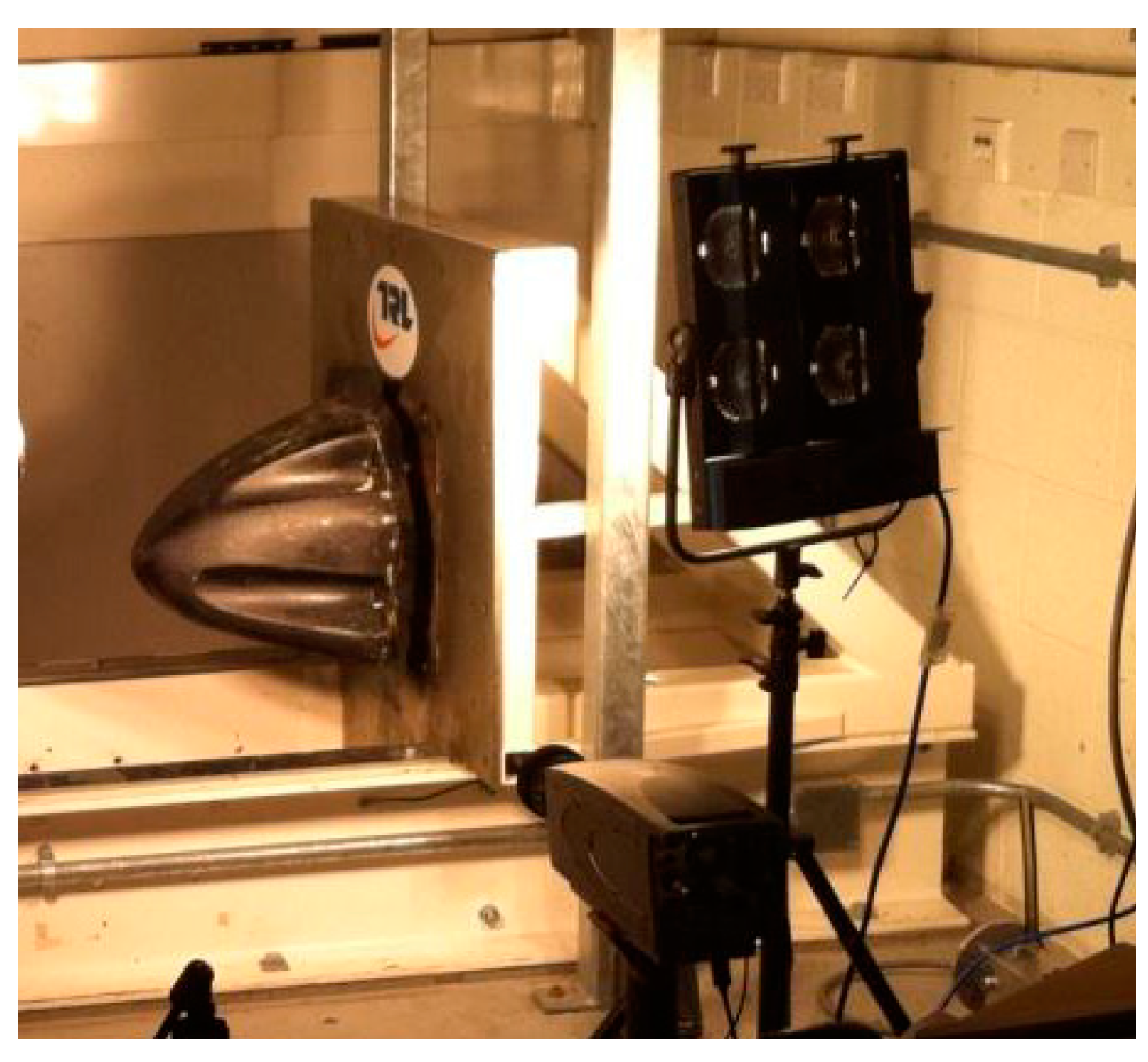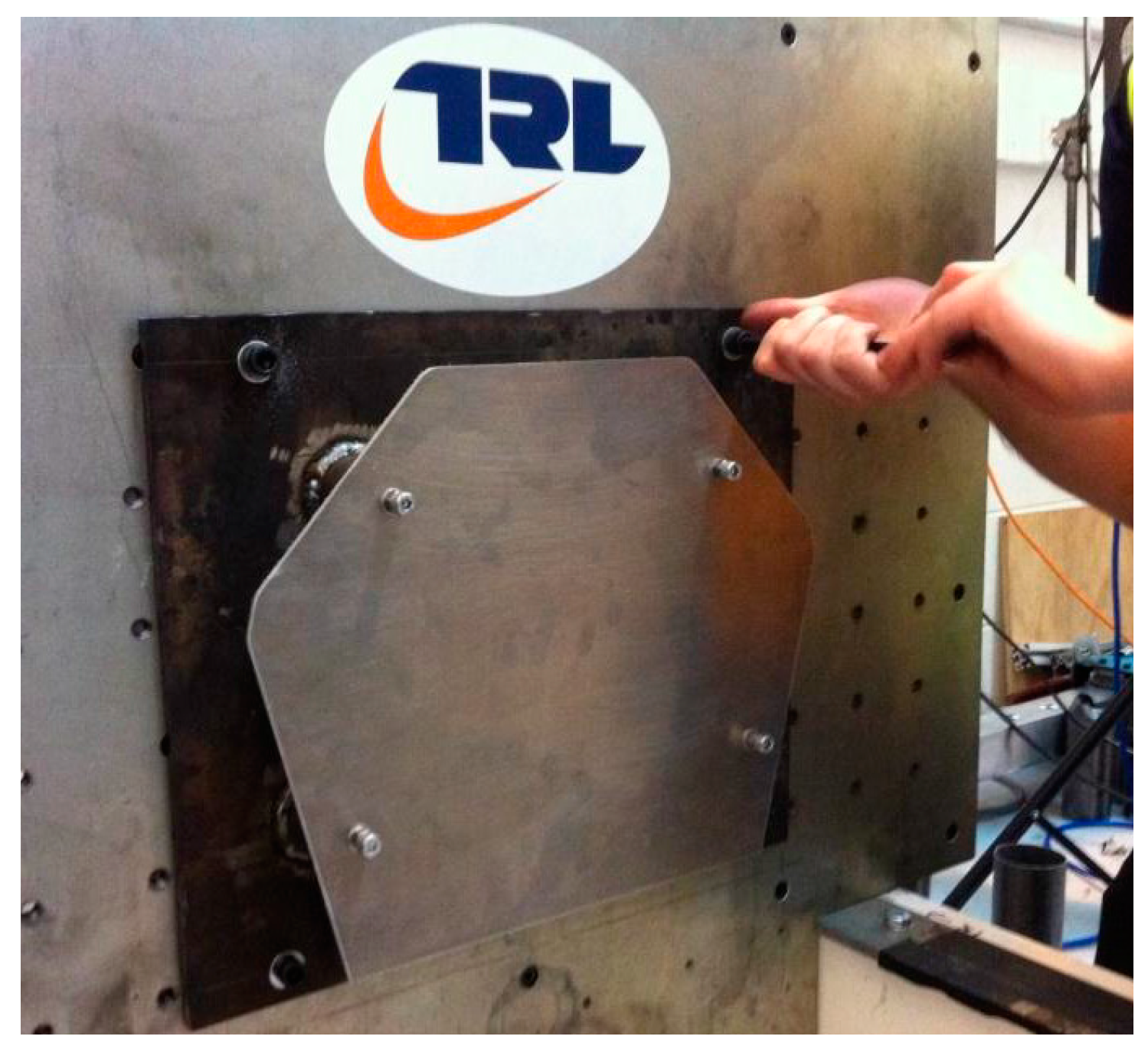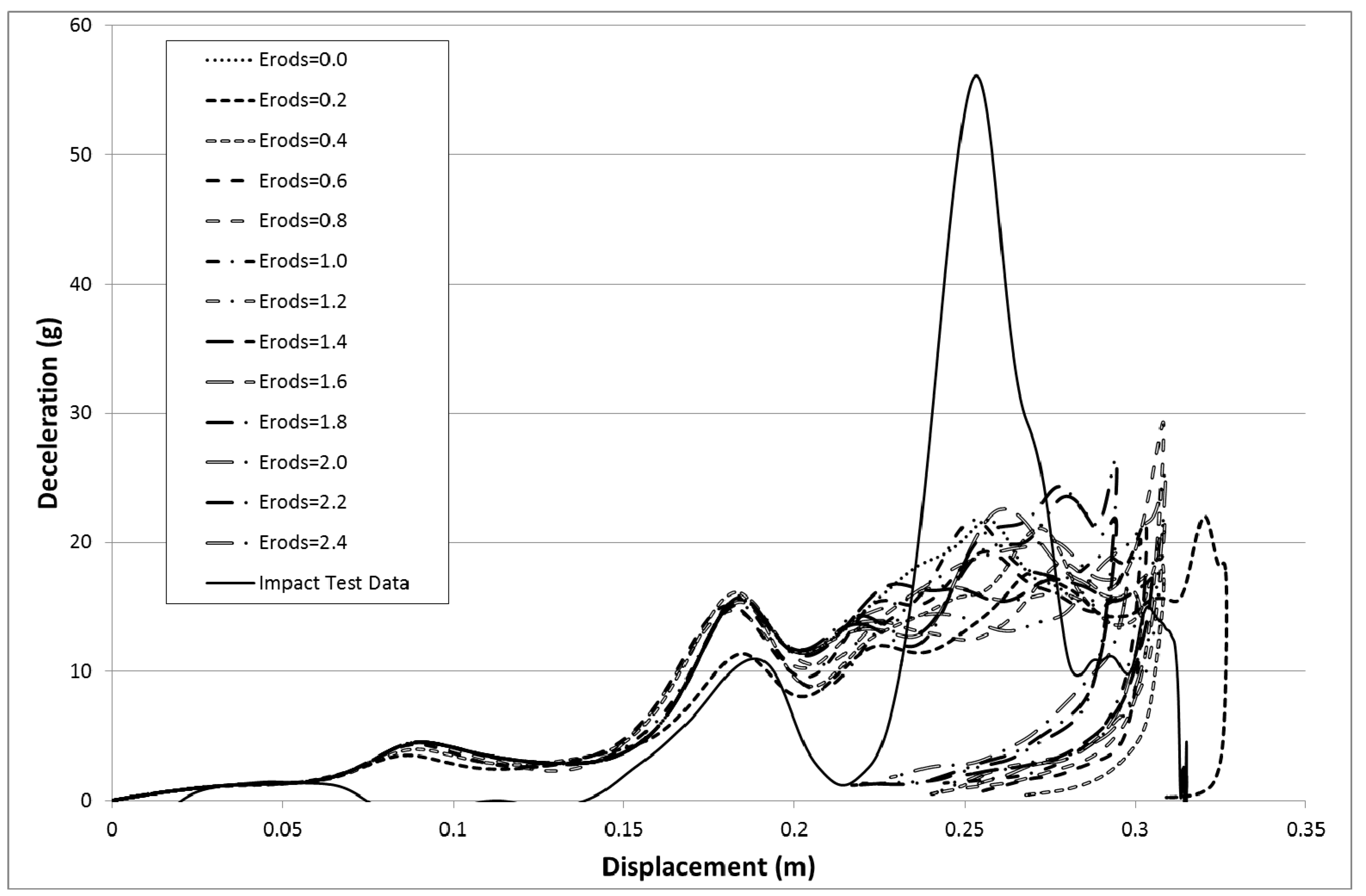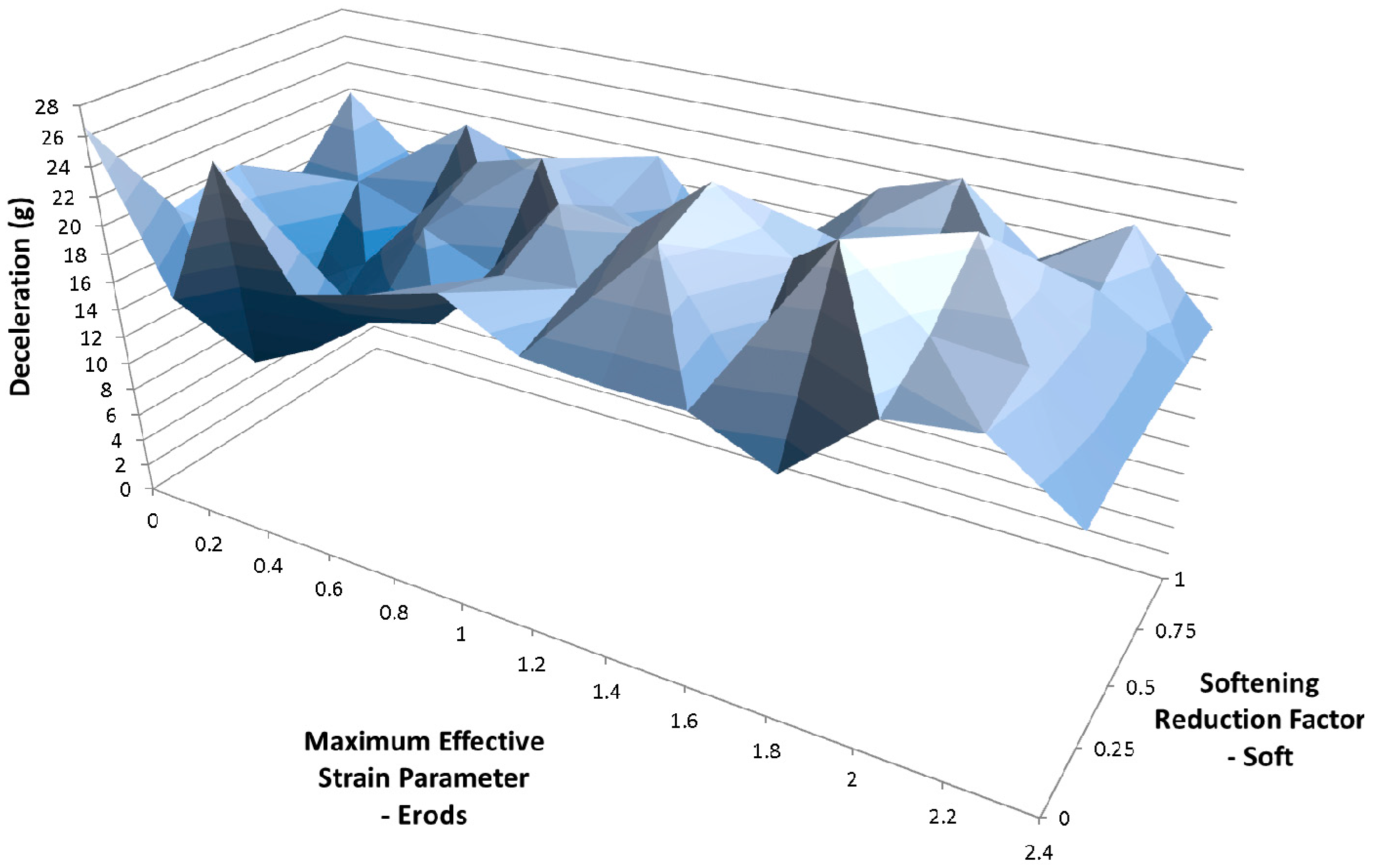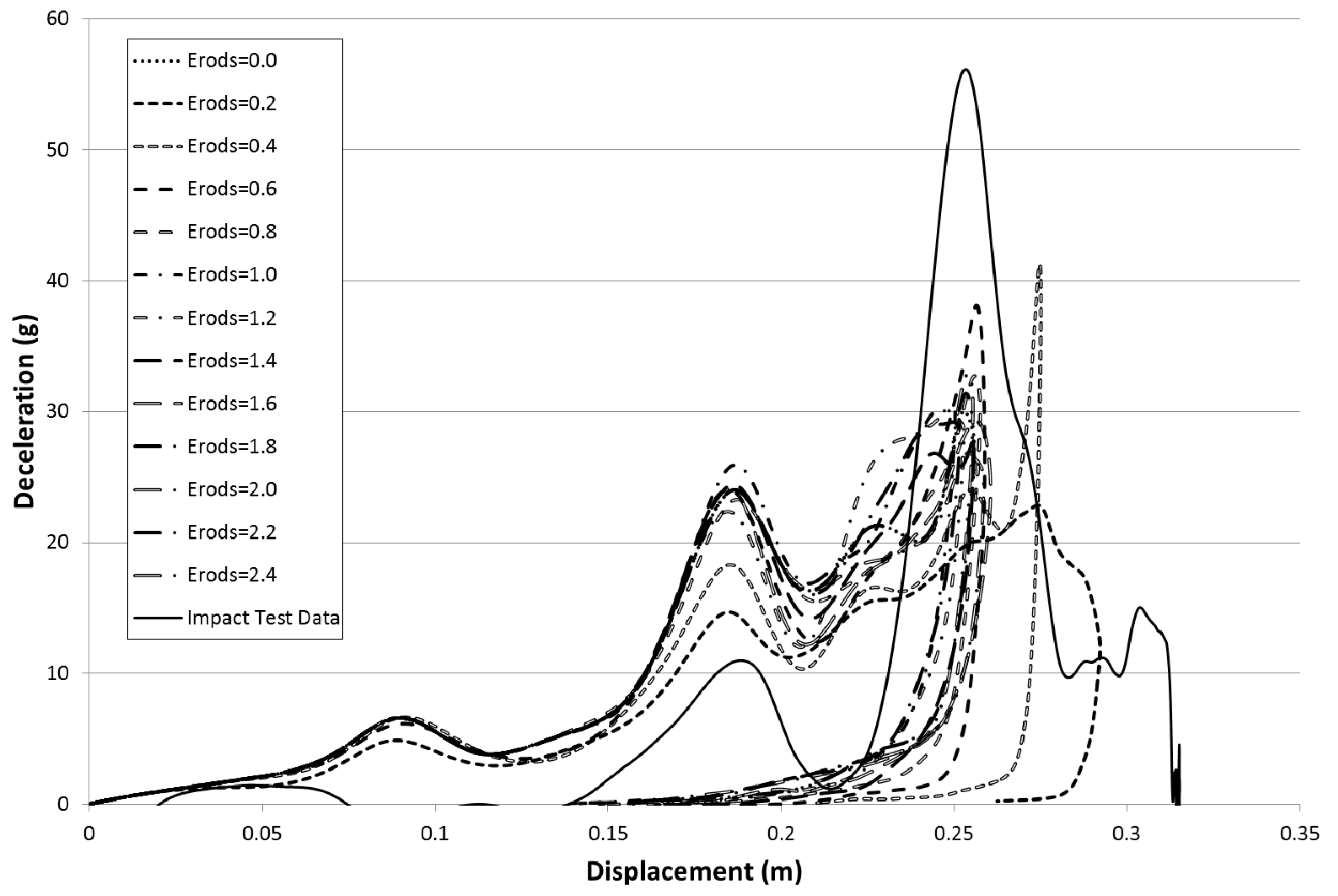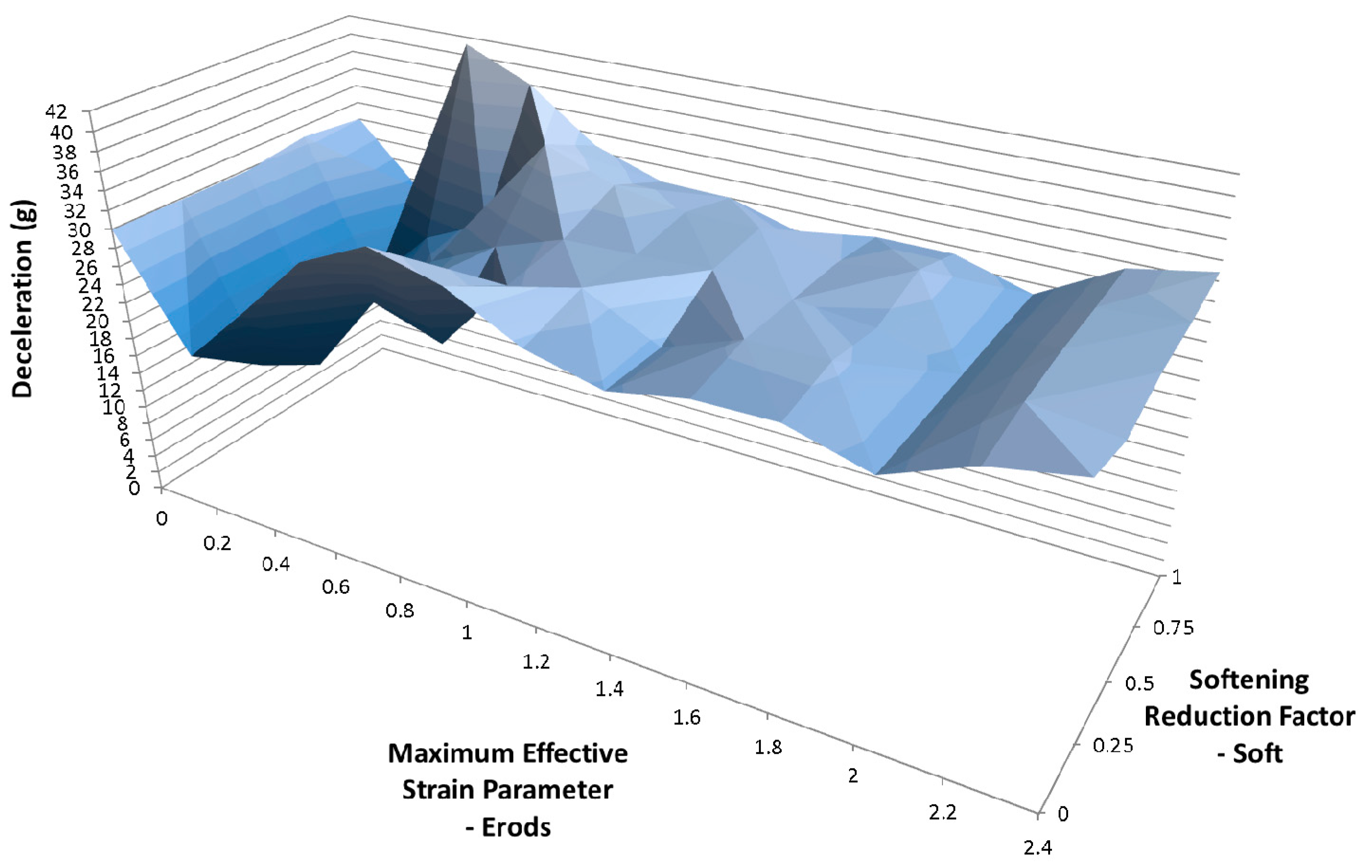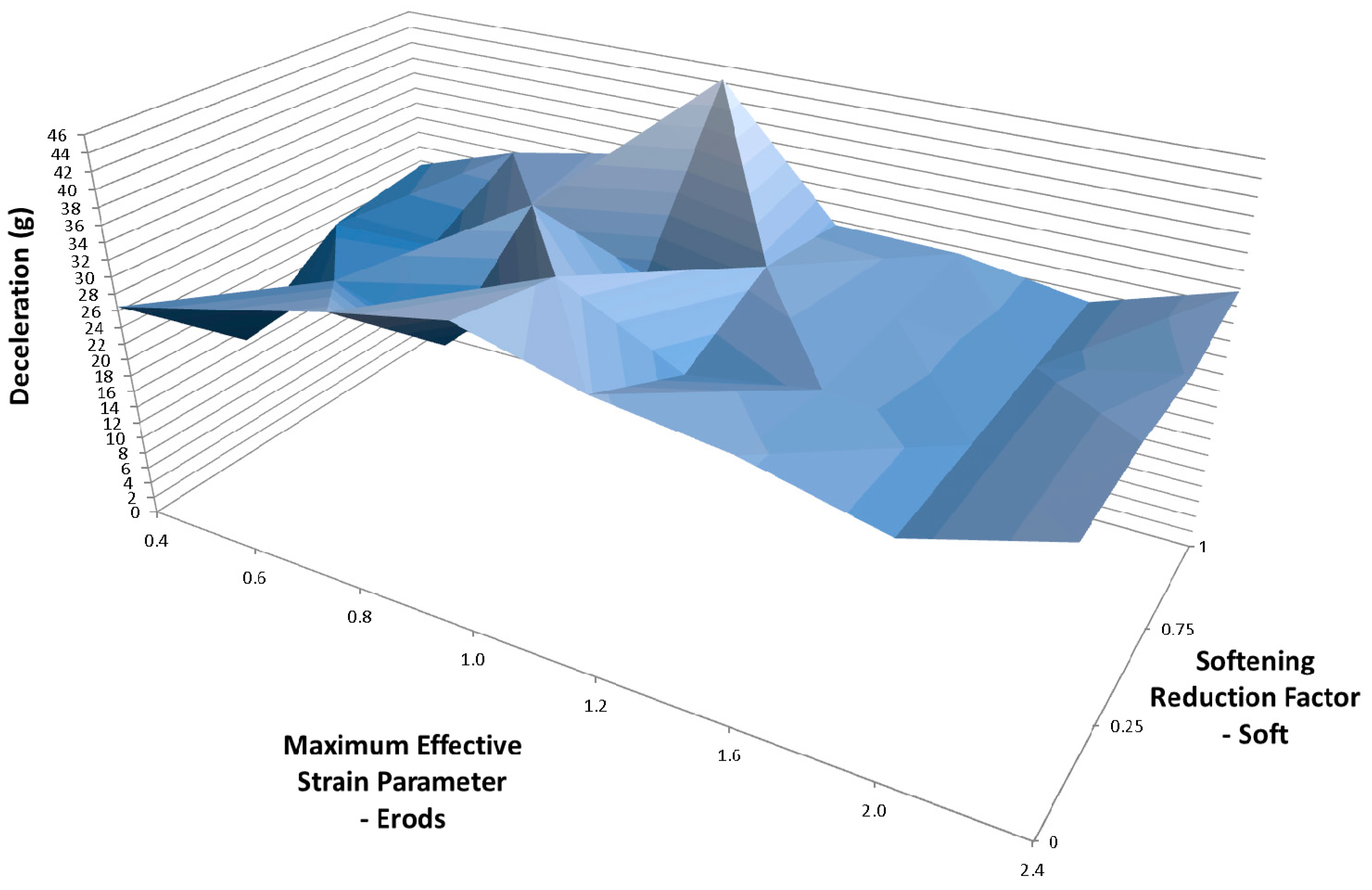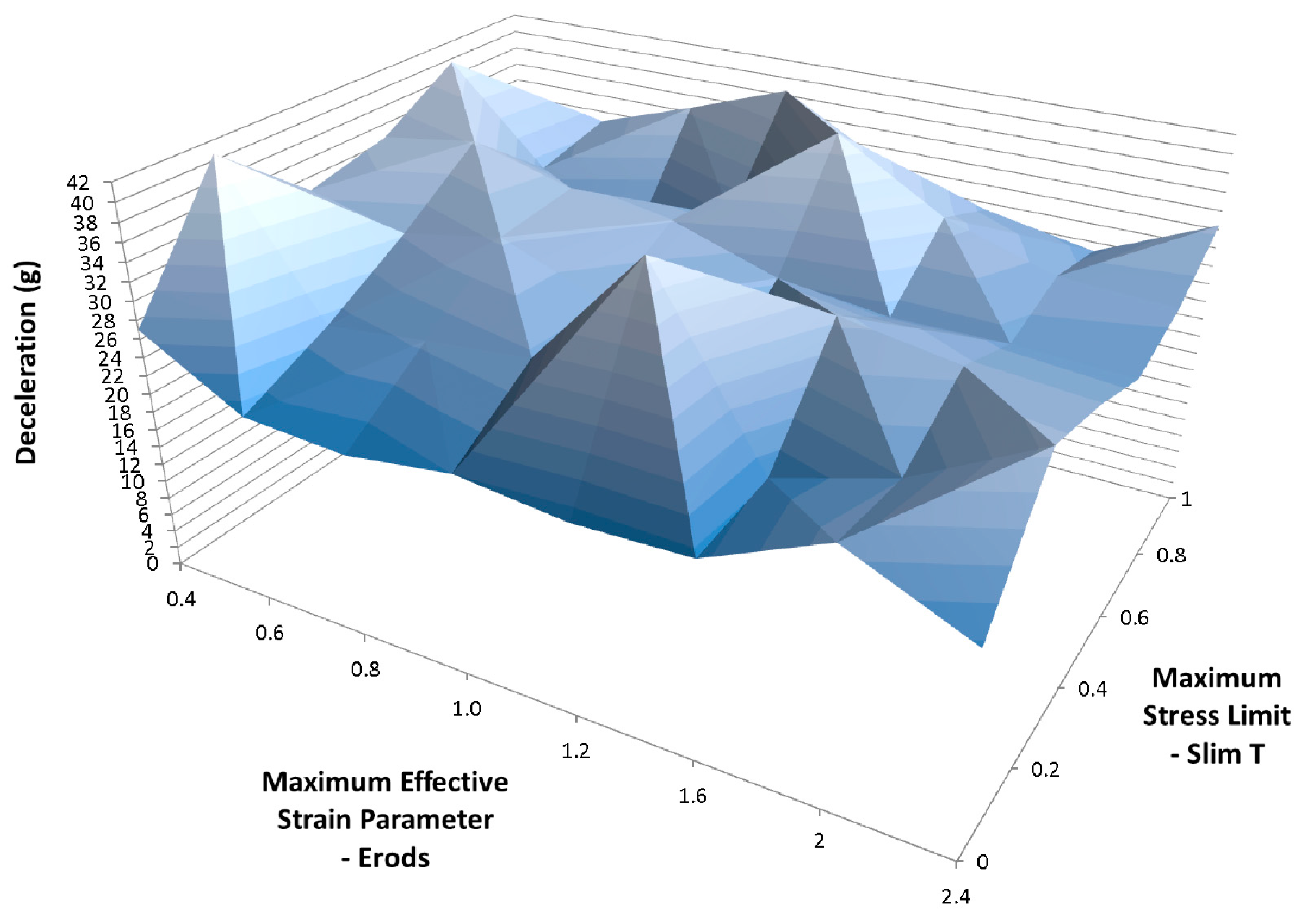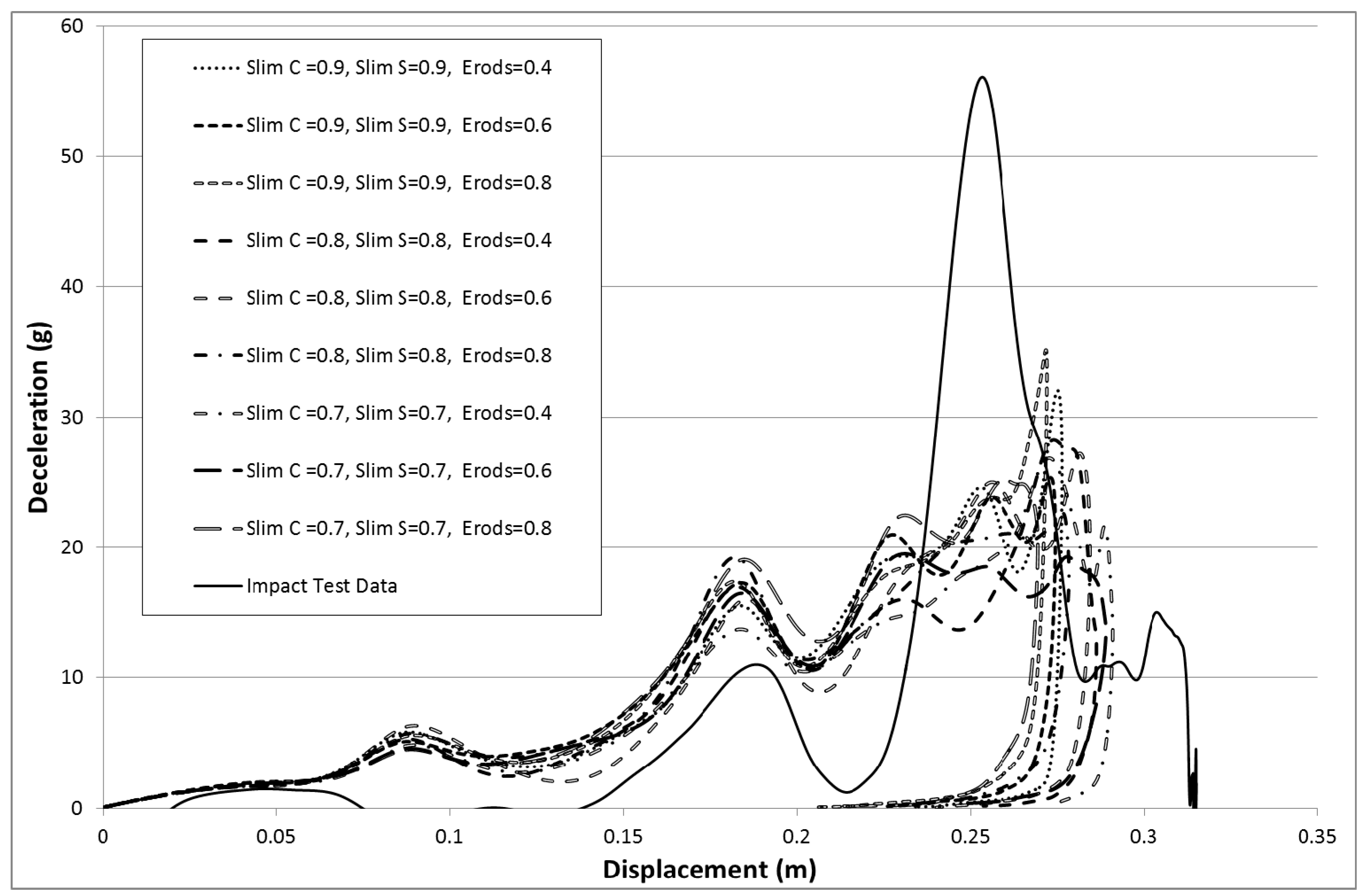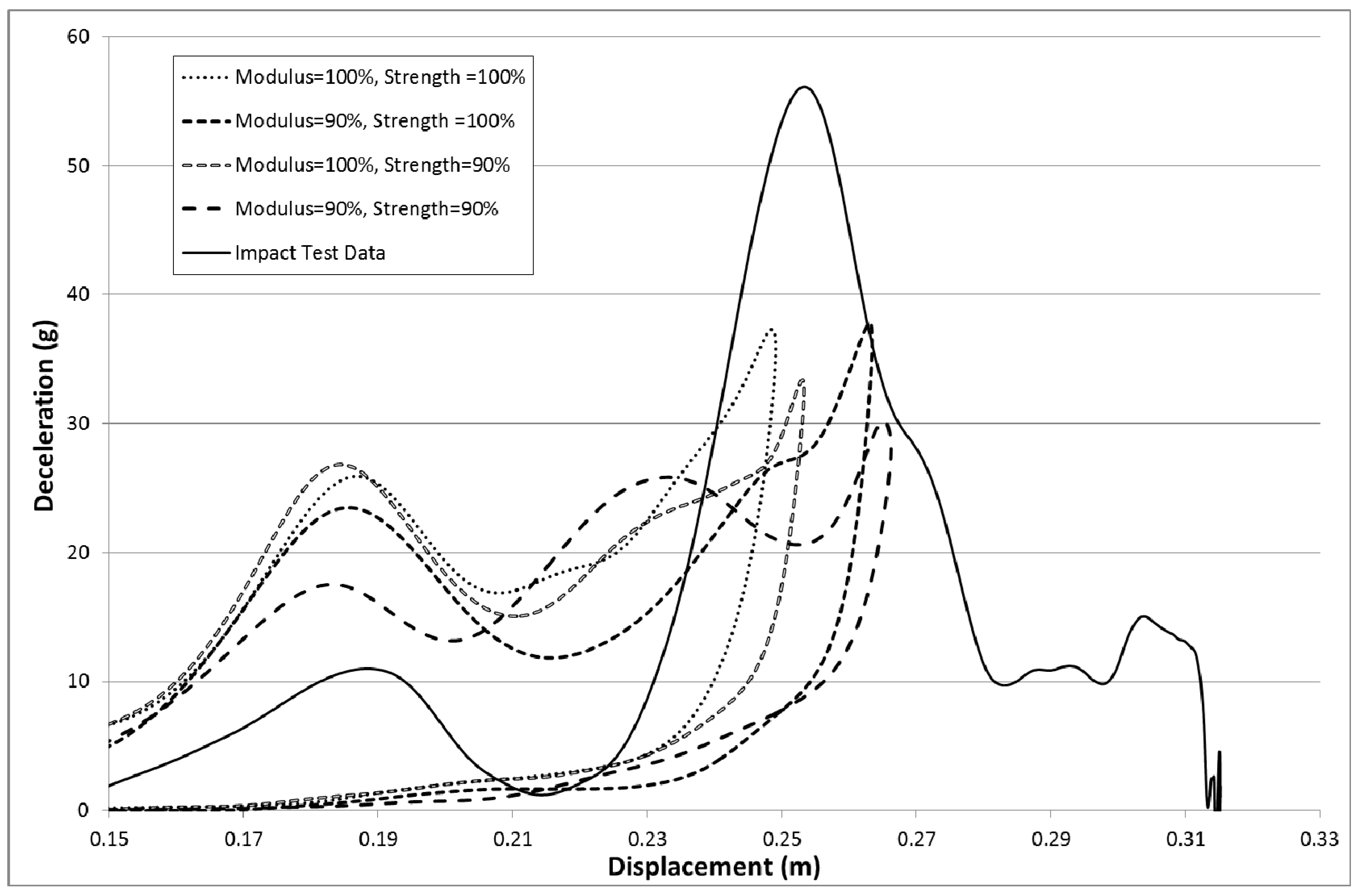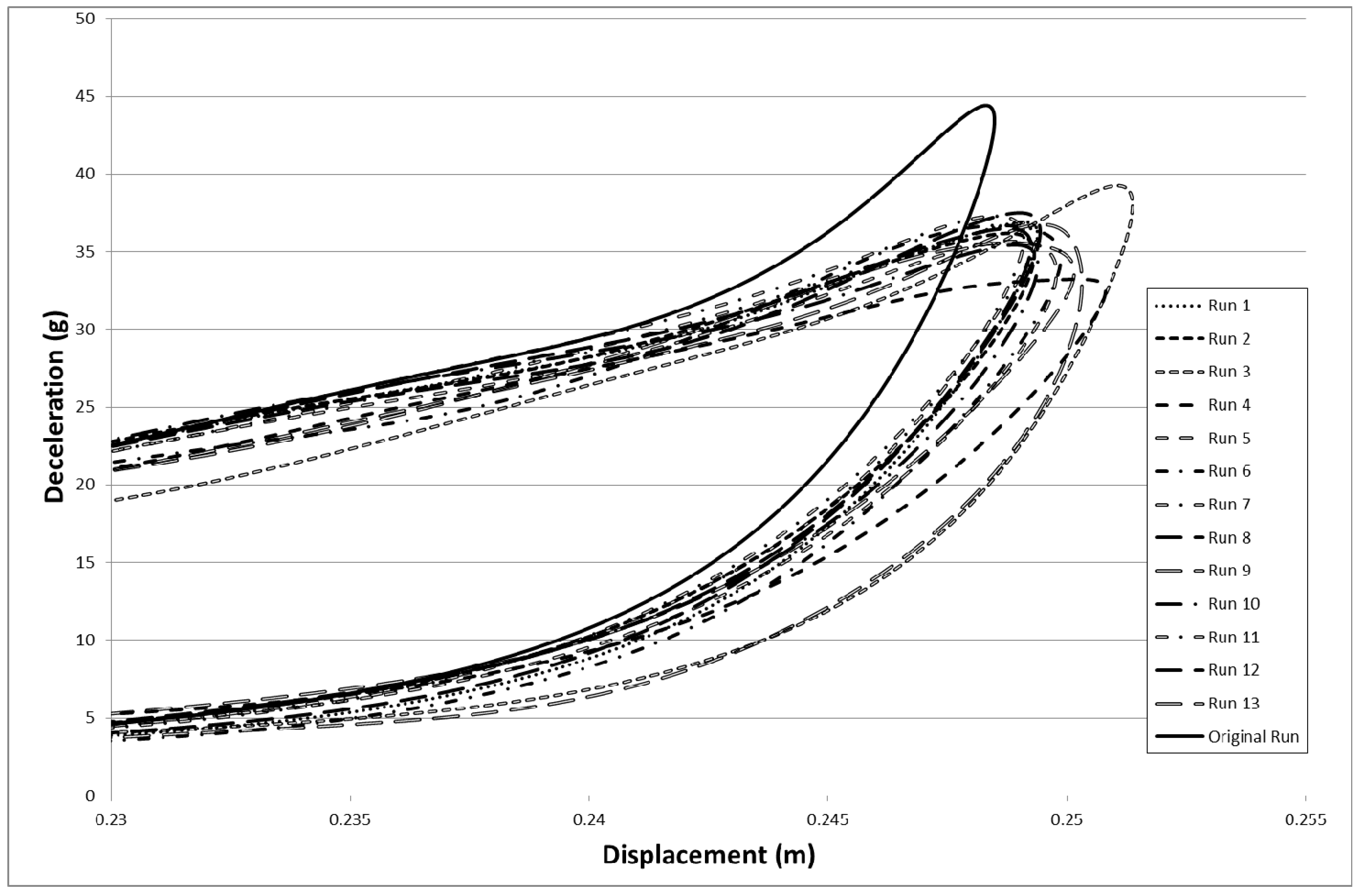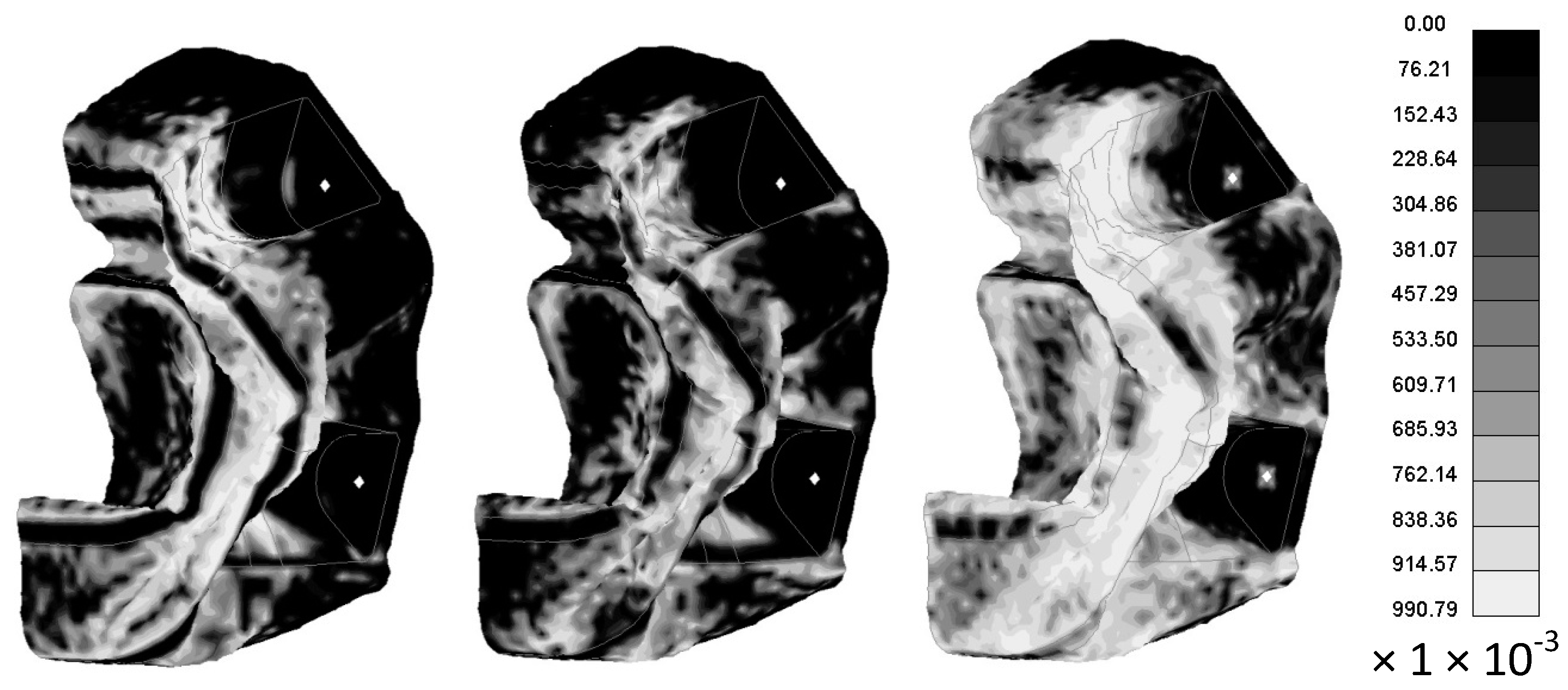Figure 1.
Geometry of Brookes XII carbon fiber reinforced composite (CFRP) nose cone [
18].
Figure 1.
Geometry of Brookes XII carbon fiber reinforced composite (CFRP) nose cone [
18].
Figure 2.
Boundary conditions applied in CFRP nose cone model.
Figure 2.
Boundary conditions applied in CFRP nose cone model.
Figure 3.
Orientation of composite material (line direction represents reference orientation).
Figure 3.
Orientation of composite material (line direction represents reference orientation).
Figure 4.
Composite layup of nose cone.
Figure 4.
Composite layup of nose cone.
Figure 5.
Effect of Slim factor (shown for longitudinal direction).
Figure 5.
Effect of Slim factor (shown for longitudinal direction).
Figure 6.
Effect of Slim factor (shown for longitudinal direction).
Figure 6.
Effect of Slim factor (shown for longitudinal direction).
Figure 7.
Sled impact tester at TRL [
18].
Figure 7.
Sled impact tester at TRL [
18].
Figure 8.
Nose cone mounting plate—showing 50 mm offset [
18].
Figure 8.
Nose cone mounting plate—showing 50 mm offset [
18].
Figure 9.
Carbon fiber nose cone after impact [
18].
Figure 9.
Carbon fiber nose cone after impact [
18].
Figure 10.
Deceleration against time obtained from the impact test.
Figure 10.
Deceleration against time obtained from the impact test.
Figure 11.
Effect of Erods parameter with All Slim = 1.0, TSize = 1 × 10−11, Soft = 1.0 and FS = 1.0.
Figure 11.
Effect of Erods parameter with All Slim = 1.0, TSize = 1 × 10−11, Soft = 1.0 and FS = 1.0.
Figure 12.
Effect of Erods parameter and Soft factor with All Slim = 1.0, TSize = 1 × 10−11 and FS = 1.0.
Figure 12.
Effect of Erods parameter and Soft factor with All Slim = 1.0, TSize = 1 × 10−11 and FS = 1.0.
Figure 13.
Effect of Erods parameter with All Slim = 1.0, TSize = 1 × 10−11, Soft = 1.0 and FS = −1.0.
Figure 13.
Effect of Erods parameter with All Slim = 1.0, TSize = 1 × 10−11, Soft = 1.0 and FS = −1.0.
Figure 14.
Effect of Erods parameter and Soft factor with All Slim = 1.0, Size = 1 × 10−11 and FS = −1.0.
Figure 14.
Effect of Erods parameter and Soft factor with All Slim = 1.0, Size = 1 × 10−11 and FS = −1.0.
Figure 15.
Effect of Erods parameter and Soft factor with All Slim = 1.0, TSize = 1 × 10−8 and FS = −1.0.
Figure 15.
Effect of Erods parameter and Soft factor with All Slim = 1.0, TSize = 1 × 10−8 and FS = −1.0.
Figure 16.
Effect of Erods parameter and Slim T parameter with Soft = 0.0, Slim C = 1.0, Slim S = 1.0, TSize = 1 × 10−8 and FS = −1.0.
Figure 16.
Effect of Erods parameter and Slim T parameter with Soft = 0.0, Slim C = 1.0, Slim S = 1.0, TSize = 1 × 10−8 and FS = −1.0.
Figure 17.
Effect of Erods parameter and Soft factor with Slim T = 0.0, Slim C = 1.0, Slim S = 1.0, TSize = 1 × 10−11 and FS = −1.0.
Figure 17.
Effect of Erods parameter and Soft factor with Slim T = 0.0, Slim C = 1.0, Slim S = 1.0, TSize = 1 × 10−11 and FS = −1.0.
Figure 18.
Effect of Erods parameter and Soft factor with Slim T = 0.2, Slim C = 1.0, Slim S = 1.0, TSize = 1 × 10−11 and FS = −1.0.
Figure 18.
Effect of Erods parameter and Soft factor with Slim T = 0.2, Slim C = 1.0, Slim S = 1.0, TSize = 1 × 10−11 and FS = −1.0.
Figure 19.
Effect of Erods parameter and Soft factor with Slim T = 0.4, Slim C = 1.0, Slim S = 1.0, TSize = 1 × 10−11 and FS = −1.0.
Figure 19.
Effect of Erods parameter and Soft factor with Slim T = 0.4, Slim C = 1.0, Slim S = 1.0, TSize = 1 × 10−11 and FS = −1.0.
Figure 20.
Effect of Erods parameter and Soft factor with Slim T = 0.6, Slim C = 1.0, Slim S = 1.0, TSize = 1 × 10−11 and FS = −1.0.
Figure 20.
Effect of Erods parameter and Soft factor with Slim T = 0.6, Slim C = 1.0, Slim S = 1.0, TSize = 1 × 10−11 and FS = −1.0.
Figure 21.
Effect of Erods parameter and Soft factor with Slim T = 0.8, Slim C = 1.0, Slim S = 1.0, TSize = 1 × 10−11 and FS = −1.0.
Figure 21.
Effect of Erods parameter and Soft factor with Slim T = 0.8, Slim C = 1.0, Slim S = 1.0, TSize = 1 × 10−11 and FS = −1.0.
Figure 22.
Effect of Slim C, Slim S and Erods parameters with Slim T = 0.1, TSize = 1 × 10−11, Soft = 0.0 and FS = −1.0.
Figure 22.
Effect of Slim C, Slim S and Erods parameters with Slim T = 0.1, TSize = 1 × 10−11, Soft = 0.0 and FS = −1.0.
Figure 23.
Effect of Slim factors with TSize = 0.0, Erods = 0.0, Soft = 0.0 and FS = −1.0.
Figure 23.
Effect of Slim factors with TSize = 0.0, Erods = 0.0, Soft = 0.0 and FS = −1.0.
Figure 24.
Effect of Erods and Slim factors with T Size = 1 × 10−9, Soft = 1.0 and FS = −1.0.
Figure 24.
Effect of Erods and Slim factors with T Size = 1 × 10−9, Soft = 1.0 and FS = −1.0.
Figure 25.
Effect of reducing modulus and failure strengths by 10% with All Slim = 1.0, TSize = 0.0, Erods = 0.0, Soft = 0.0 (no softening as TSize = 0.0) and FS = −1.0.
Figure 25.
Effect of reducing modulus and failure strengths by 10% with All Slim = 1.0, TSize = 0.0, Erods = 0.0, Soft = 0.0 (no softening as TSize = 0.0) and FS = −1.0.
Figure 26.
Investigation of mesh sensitivity with three runs using the same model input file with All Slim = 1.0, TSize = 1 × 10−8, Erods = 1.0, Soft = 1.0 and FS = −1.0.
Figure 26.
Investigation of mesh sensitivity with three runs using the same model input file with All Slim = 1.0, TSize = 1 × 10−8, Erods = 1.0, Soft = 1.0 and FS = −1.0.
Figure 27.
Investigation of time-step sensitivity with fourteen runs using the same model input file with All Slim = 1.0, TSize = 1 × 10−8, Erods = 1.0, Soft = 1.0 and FS = −1.0.
Figure 27.
Investigation of time-step sensitivity with fourteen runs using the same model input file with All Slim = 1.0, TSize = 1 × 10−8, Erods = 1.0, Soft = 1.0 and FS = −1.0.
Figure 28.
D3Plot images of wall hitting nose cone at 0, 0.25, 0.5, 0.75 and 0.1 s of LS-Dyna model with settings All Slim = 1.0, TSize = 1 × 10−9, Erods = 1.0, Soft = 0.0 and FS = −1.0.
Figure 28.
D3Plot images of wall hitting nose cone at 0, 0.25, 0.5, 0.75 and 0.1 s of LS-Dyna model with settings All Slim = 1.0, TSize = 1 × 10−9, Erods = 1.0, Soft = 0.0 and FS = −1.0.
Figure 29.
D3Plot image of damage after impact of LS-Dyna model with settings All Slim = 1.0, TSize = 1 × 10−9, Erods = 1.0, Soft = 0.0 and FS = −1.0.
Figure 29.
D3Plot image of damage after impact of LS-Dyna model with settings All Slim = 1.0, TSize = 1 × 10−9, Erods = 1.0, Soft = 0.0 and FS = −1.0.
Figure 30.
D3Plot images of longitudinal, transverse and shear damage (respectively) after impact of LS-Dyna model with settings All Slim = 1.0, TSize = 1 × 10−9, Erods = 1.0, Soft = 0.0 and FS = −1.0 (Black undamaged: 0, White fully damaged: 1).
Figure 30.
D3Plot images of longitudinal, transverse and shear damage (respectively) after impact of LS-Dyna model with settings All Slim = 1.0, TSize = 1 × 10−9, Erods = 1.0, Soft = 0.0 and FS = −1.0 (Black undamaged: 0, White fully damaged: 1).
Table 1.
Mesh Parameters.
Table 1.
Mesh Parameters.
| Mesh Name | Element Size | Automatic Mesh Capture Size | Element Type |
|---|
| Mesh_7 mm | 7 mm | 3.6 mm | Linear Quad |
| Mesh_5 mm | 5 mm | 2.6 mm | Linear Quad |
| Mesh_3 mm | 3 mm | 1.6 mm | Linear Quad |
Table 2.
Carbon-epoxy prepreg woven properties.
Table 2.
Carbon-epoxy prepreg woven properties.
| Property | CF3202/MTM57 [23] | CFS003/LTM25 [25] | Material Properties Used in the Model |
|---|
| Cloth specific weight | 245 g/m2 | - | - |
| Volume fraction | - | 46.9% | - |
| Density | - | 1453 kg/m3 | 1408 kg/m3 |
| Young’s tensile modulus in longitudinal direction E11t | 64.2 × 109 Pa | 48.7 × 109 Pa | 64.6 × 109 Pa |
| Young’s tensile modulus in longitudinal direction E11c | - | 49.64 × 109 Pa | - |
| Young’s tensile modulus in transverse direction E22t | 65.1 × 109 Pa | 51.8 × 109 Pa | 64.6 × 109 Pa |
| Young’s compressive modulus in transverse direction E22c | - | 54.1 × 109 Pa | - |
| Poisson’s ratio ν12 | 0.05 | 0.042 | - |
| Poisson’s ratio ν21 | 0.05 | 0.035 | 0.05 |
| Shear modulus G12 | - | 2.85 × 109 Pa | 2.85 × 109 Pa |
| Shear modulus G23 | - | - | 2.85 × 109 Pa |
| Shear modulus G31 | - | - | 2.85 × 109 Pa |
| Longitudinal ultimate tensile stress σ11ut | 642 × 106 Pa | 562.6 × 106 Pa | 642 × 106 Pa |
| Longitudinal ultimate compressive stress σ11uc | - | 641.9 × 106 Pa | 642 × 106 Pa |
| Transverse ultimate tensile stress σ22ut | 665 × 106 Pa | 612.3 × 106 Pa | 665 × 106 Pa |
| Transverse ultimate compressive stress σ22uc | - | 563.3 × 106 Pa | 563 × 106 Pa |
| In plane ultimate shear stress τ12uIP | - | 84.12 × 106 Pa | 84 × 106 Pa |
| Interlaminar ultimate shear stress τ12uIL | 71.5 × 106 Pa | - | - |
Table 3.
Additional material parameters set within the model [
19,
29].
Table 3.
Additional material parameters set within the model [
19,
29].
| Material Parameter Set | Meaning |
|---|
| Slim T (Slim1T & Slim2T) | Factor to determine the minimum tensile stress limit after tensile failure (fiber and matrix can be set separately but were kept the same). A value of one will prevent stress reduction and a value of zero will reduce the stress to zero. |
| Slim C (Slim1C & Slim2C) | Factor to determine the minimum compressive stress limit after compressive failure (fiber and matrix can be set separately but were kept the same). A value of one will prevent stress reduction and a value of zero will reduce the stress to zero. |
| Slim S (SlimS) | Factor to determine the minimum shear stress limit after shear stress failure. A value of one will prevent stress reduction and a value of zero will reduce the stress to zero. |
| TSize | Time step for automatic element deletion. The crashfront-algorithm is started if a value for TSIZE is input (Soft Factor). |
| Erods | Maximum effective strain for element layer deletion. A value of unity equals a 100% strain. |
| Soft | Reduces material strength in elements immediately behind the crash front. The strength reduction increases as the value goes from one (no reduction) to zero [
17]. |
| FS | EQ.1.0: smooth failure surface; EQ.−1.0: faceted failure surface. |
Table 4.
Parameters for control section of model.
Table 4.
Parameters for control section of model.
| Control Card | Control Item | Value Set | Effect |
|---|
| Shell | ESORT | 1 | Assigns triangular element formulation (Elform 4) to unassigned triangular elements. |
| LAMSHT | 1 | Corrects for assumption of uniform transverse strain through shell thickness. |
| Termination | ENDTIM | 0.1 | Sets the maximum run time for the model. |
Table 5.
Additional control section parameters.
Table 5.
Additional control section parameters.
| Hourglass | IHQ | 4 | Viscosity added to shell elements to prevent hourglassing. A value of 4 utilizes the stiffness form of Flanagan-Belytschko. |
| QH | 0.03 | Hourglass coefficient. |
| Accuracy | INN | 2 | When set to 2 invariant node numbering is applied to shell and thick shell elements. |
Table 6.
Contact friction values.
Table 6.
Contact friction values.
| Friction Variables | Value Set | Effect |
|---|
| FS | 0.25 | Sets the static friction value |
| FD | 0.2 | Sets the dynamic friction value |
Table 7.
Parameter used in different model runs (Part 1).
Table 7.
Parameter used in different model runs (Part 1).
| Parameter | Set 1 | Set 2 | Set 3 | Set 4 | Set 5 |
|---|
| Element Size | 7 mm | 7 mm | 7 mm | 7 mm | 7 mm |
| Soft | 0.0–1.0 (0.25 steps) | 0.0–1.0 (0.25 steps) | 0.0–1.0 (0, 0.25, 075, 1.0) | 0.0 | 0.0–1.0 (0.25 steps) |
| Slim T | 1.0 | 1.0 | 1.0 | 0.0–1.0 (0.2 Steps) | 0.0–0.8 (0.2 Steps) |
| Slim C | 1.0 | 1.0 | 1.0 | 1.0 | 1.0 |
| Slim S | 1.0 | 1.0 | 1.0 | 1.0 | 1.0 |
| Erods | 0–2.4 (0.2 Steps) | 0–2.4 (0.2 Steps) | 0–2.4 (0.2 steps) | 0.4–1.0 (0.2 steps), 1.2–2.4 (0.4 steps) | 0.4–1.0 (0.2 steps) |
| TSize | 1 × 10−11 | 1 × 10−11 | 1 × 10−8 | 0.0 | 1× 10−11 |
| Modulus | Normal | Normal | Normal | Normal | Normal |
| Strength | Normal | Normal | Normal | Normal | Normal |
| FS | −1.0 | 1.0 | −1.0 | −1.0 | −1.0 |
Table 8.
Parameter used in different model runs (Part 2).
Table 8.
Parameter used in different model runs (Part 2).
| Parameter | Set 6 | Set 7 | Set 8 | Set 9 | Set 10 |
|---|
| Element Size | 7 mm | 7 mm | 7 mm | 3, 5 and 7 mm | 7 mm |
| Soft | 0.0 | 0.0 | 1.0 | 0.0 | 1.0 |
| Slim T | 0.1 | 0.4, 0.6. 0.7. 0.8, 0.9, 1.0 | 0.6–1 (0.1 Steps) | 1.0 | 1.0 |
| Slim C | 0.7–0.9 (0.1 steps) | 1.0 | 1.0 |
| Slim S | 1.0 | 1.0 | 1.0 |
| Erods | 0.4–0.8 (0.2 steps) | 0.0 | 0–1 (0.2 Steps) | 0.0 | 1.0 |
| TSize | 1 × 10−11 | 0.0 | 1 × 10−7, 1 × 10−8, 1 × 10−9 | 0.0 | 1× 10−8 |
| Modulus | Normal | Normal | Normal | Normal | 90–100% of Normal |
| Strength | Normal | Normal | Normal | Normal | 90–100% of Normal |
| FS | −1.0 | −1.0 | −1.0 | −1.0 | −1.0 |
Table 9.
Parameter used in different model runs (Part 3).
Table 9.
Parameter used in different model runs (Part 3).
| Parameter | Set 11 | Set 12 | Set 13 | Set 14 |
|---|
| Element Size | 7 mm | 7 mm | 7 mm | 7 mm |
| Soft | 0.0 | 0.0 | 1.0 | 1.0 |
| Slim T | 1.0 | 1.0 | 1.0 | 1.0 |
| Slim C | 1.0 | 1.0 | 1.0 | 1.0 |
| Slim S | 1.0 | 1.0 | 1.0 | 1.0 |
| Erods | 0.0 | 1.0 | 0.0 | 1.0 |
| TSize | 1 × 10−7, 1 × 10−8, 1 × 10−9, 1 × 10−10, 1 × 10−11 | 1 × 10−7, 1 × 10−8, 1 × 10−9, 1 ×10−10, 1 × 10−11 | 1 × 10−7, 1 × 10−8, 1 × 10−9, 1 ×10−10, 1 × 10−11 | 1 × 10−7, 1 × 10−8, 1 × 10−9, 1 ×10−10, 1 × 10−11 |
| Modulus | Normal | Normal | Normal | Normal |
| Strength | Normal | Normal | Normal | Normal |
| FS | 1.0, −1.0 | 1.0, −1.0 | 1.0, −1.0 | 1.0, −1.0 |
Table 10.
Mean and standard deviations (St Dev) for peak deceleration values (0.23 m < wall displacement < 0.29 m), for parameter sets 11 to 14, based on five runs for each given value.
Table 10.
Mean and standard deviations (St Dev) for peak deceleration values (0.23 m < wall displacement < 0.29 m), for parameter sets 11 to 14, based on five runs for each given value.
| Smooth Failure Surface (FS = 1) |
| Tsize | Set 11 | Set 12 | Set 13 | Set 14 |
| Soft = 0.0, All Slim = 1.0, Erods = 0.0 | Soft = 0.0, All Slim = 1.0, Erods = 1.00 | Soft = 1.0, All Slim = 1.0, Erods = 0.0 | Soft = 1.0, All Slim = 1.0, Erods = 1.0 |
| Mean | St Dev | Mean | St Dev | Mean | St Dev | Mean | St Dev |
| 1 × 10−7 | 8.53 | 1.59 | 21.67 | 0.03 | 20.22 | 1.35 | 21.67 | 0.03 |
| 1 × 10−8 | 20.20 | 1.28 | 21.66 | 0.05 | 21.32 | 2.25 | 21.28 | 0.90 |
| 1 × 10−9 | 19.94 | 1.69 | 21.50 | 0.37 | 17.36 * | 2.81 * | 21.31 | 2.04 |
| 1 × 10−10 | 19.84 | 1.35 | 21.68 * | 0.02 * | 20.03 | 1.30 | 22.00 | 0.73 |
| 1 × 10−11 | 19.75 | 1.19 | 21.67 | 0.04 | 19.34 | 0.69 | 21.67 | 0.03 |
| Facetted Failure Surface (FS = −1) |
| Tsize | Set 11 | Set 12 | Set 13 | Set 14 |
| Soft = 0.0, All Slim = 1.0, Erods = 0.0 | Soft = 0.0, All Slim = 1.0, Erods = 1.0 | Soft = 1.0, All Slim = 1.0, Erods = 0.0 | Soft = 1.0, All Slim = 1.0, Erods = 1.0 |
| Mean | St Dev | Mean | St Dev | Mean | St Dev | Mean | St Dev |
| 1 × 10−7 | 30.36 | 0.65 | 34.95 | 3.97 | 29.82 | 0.17 | 36.20 | 2.53 |
| 1 × 10−8 | 29.62 | 0.19 | 36.84 | 3.33 | 30.03 | 0.70 | 38.55 | 2.20 |
| 1 × 10−9 | 30.17 | 0.59 | 39.99 | 2.66 | 30.29 | 1.08 | 35.84 | 3.15 |
| 1 × 10−10 | 31.50 | 1.99 | 36.05 | 2.47 | 30.70 | 2.02 | 35.13 | 3.58 |
| 1 × 10−11 | 29.95 | 0.42 | 34.85 | 2.74 | 30.38 | 0.67 | 34.02 | 1.84 |
Table 11.
Mean and standard deviations (St Dev) for peak deceleration values (0.23 m < wall displacement < 0.29 m) based on five runs of previous high peak models.
Table 11.
Mean and standard deviations (St Dev) for peak deceleration values (0.23 m < wall displacement < 0.29 m) based on five runs of previous high peak models.
| Facetted Failure Surface (FS = −1), Slim C = 1.0, Slim S = 1.0 |
|---|
| Tsize | Soft = 1.0, Erods = 0.6, Slim T = 1.0 (Figure 13) | Soft = 0.0, Erods = 1.2, Slim T = 0.2 (Figure 16) | Soft = 0.0, Erods = 0.4, Slim T = 0.2 (Figure 18) |
|---|
| Mean | St Dev | Mean | St Dev | Mean | St Dev |
|---|
| 1 × 10−11 | 28.06 | 2.33 | 29.95 | 3.96 | 30.00 | 3.18 |
